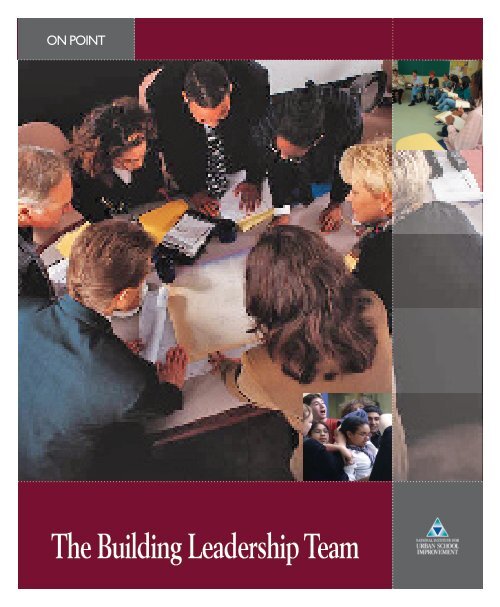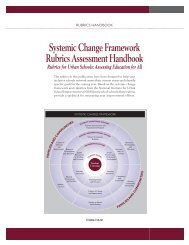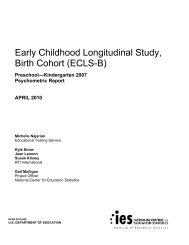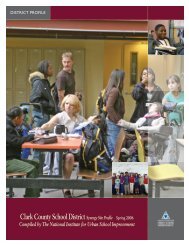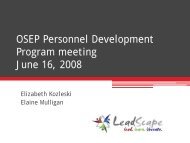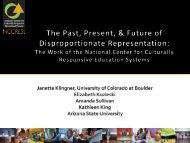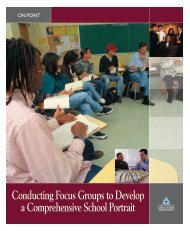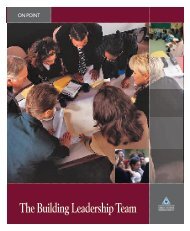The Building Leadership Team - NIUSI Leadscape
The Building Leadership Team - NIUSI Leadscape
The Building Leadership Team - NIUSI Leadscape
Create successful ePaper yourself
Turn your PDF publications into a flip-book with our unique Google optimized e-Paper software.
ON POINT<br />
<strong>The</strong> <strong>Building</strong> <strong>Leadership</strong> <strong>Team</strong>
<strong>The</strong> mission of the National Institute for Urban School Improvement<br />
is to partner with Regional Resource Centers to develop powerful networks<br />
of urban local education agencies and schools that embrace and implement a<br />
d a t a - b a s e d , c o n t i n u o u s i m p r o v e m e n t a p p r o a c h f o r i n c l u s i v e p r a c t i c e s .<br />
Embedded within this approach is a commitment to evidence-based practice<br />
in early intervention, universal design, literacy and positive behavior supports.<br />
<strong>The</strong> Office of Special Education Programs (OSEP), of the U.S. Department of<br />
Education, has funded <strong>NIUSI</strong> to facilitate the unification of current general and<br />
special education reform efforts as these are implemented in the nation’s urban<br />
school districts. <strong>NIUSI</strong>’s creation reflects OSEP’s long-standing commitment to<br />
improving educational outcomes for all children, specifically those with<br />
disabilities, in communities challenged and enriched by the urban experience.<br />
Great Urban Schools: Learning Together Builds Strong Communities
1<br />
ON POINT SERIES<br />
<strong>The</strong> <strong>Building</strong> <strong>Leadership</strong> <strong>Team</strong><br />
National Institute for Urban School Improvement<br />
University of Colorado at Denver and Health Sciences Center<br />
In Collaboration with:<br />
<strong>The</strong> Colorado Department of Education<br />
Peak Parent Center<br />
<strong>The</strong> Silc Road<br />
©2005 <strong>NIUSI</strong>
2<br />
sharing leadership<br />
What is a <strong>Building</strong> <strong>Leadership</strong> <strong>Team</strong>?<br />
A <strong>Building</strong> <strong>Leadership</strong> <strong>Team</strong> (BLT) is a<br />
school-based group of individuals who work<br />
to provide strong organizational process for<br />
school renewal and improvement. BLTs<br />
orchestrate the work of school professionals,<br />
administrators, families, and students through<br />
the school improvement process. This process<br />
includes the examination of current, successful<br />
practices and also those areas that are of<br />
concern to the school community. In addition,<br />
BLTs plan for progress, achievement, and risk.<br />
<strong>Team</strong> leadership helps to facilitate rapid and<br />
sustained change. Often, circumstances such<br />
as high turnover, classroom isolation, and<br />
limited executive authority make it difficult<br />
for schools to make the decisions needed for<br />
improvement. <strong>Leadership</strong> teams then can<br />
provide a context for decision making. <strong>The</strong><br />
use of BLTs emphasizes the need for clear<br />
sanction and participation from other school<br />
staff, reasonable delegation of responsibility<br />
and authority from the district office and<br />
board, and resources for the team’s work.<br />
<strong>The</strong> BLT meets regularly throughout the<br />
school year to ensure that both planning for<br />
school improvement and the implementation<br />
of those plans is on course. When necessary, the<br />
BLT works to develop or change building<br />
policies so that policies, procedures, and<br />
activities work together to support the work of<br />
educators and students. BLTs are responsible<br />
for collecting data in order to identify topics<br />
and processes for professional development.<br />
<strong>The</strong>y help keep the focus on a few specific<br />
targets and work with the building principal to<br />
assure that administrative structures support<br />
the instructional program.<br />
Do BLTs replace principals? Principals<br />
are like conductors. <strong>The</strong>y can’t make music<br />
without their musicians but they lead the<br />
process of performing. Principals are<br />
responsible to the central administration and<br />
ultimately to the School Board to ensure that<br />
the policies and processes established for the<br />
district as a whole are implemented in their<br />
buildings. <strong>The</strong>y must assure that the safety<br />
and security of students and staff alike are<br />
maintained. Principles are accountable for the<br />
overall academic achievement of all learners<br />
in their building. Evaluation and mentoring of<br />
school professionals in the building is a vital<br />
and time-consuming part of each principal’s<br />
role. Because of these responsibilities, the<br />
principal plays a critical role in shaping the<br />
agendas for each building leadership team.<br />
What’s the commitment? BLT members<br />
are committing themselves to the equivalent of<br />
about an hour and a half per week of meeting<br />
time. Meetings may occur weekly, every other<br />
week, or when a team is well-established<br />
monthly. BLT members are also committing<br />
themselves to work completed between<br />
meetings. In addition, the BLT will have at least<br />
one retreat at the beginning of each year to<br />
establish a working plan. <strong>Team</strong>s may also choose<br />
to meet at the end of the year to assess progress<br />
and complete an annual review of progress. BLT
3<br />
members will have the opportunity to network<br />
with other school BLTs via electronic mail and<br />
face-to-face at conferences and meetings.<br />
building the team<br />
Who should be a member? Membership<br />
on the team should be diverse. You’ll want to<br />
consider students, practitioners, family and<br />
community members, and administrative staff.<br />
Because a leadership team must be sustainable<br />
over time, consider staggering the terms for<br />
members, thus ensuring a smoother transition<br />
for new members and less disruption to the<br />
team’s work. Ensure that as many people as<br />
possible of selecting members for the team.<br />
Decide on a process for how members are<br />
selected or nominated for the team. <strong>The</strong>se<br />
questions should be considered:<br />
• At the elementary level, is each grade level<br />
represented?<br />
• How are special education members included?<br />
• At the secondary level, should members<br />
represent teams? Content area? Grade level?<br />
• Do parents represent the diversity present<br />
in the school community ( i.e., second<br />
language learners)?<br />
• Will students directly participate or will<br />
there be a process to include their voices in<br />
decision making?<br />
Who does what? Part of “building the<br />
team” is sharing the responsibilities that<br />
accompany the running of any meeting.<br />
<strong>The</strong> following are process roles that the team<br />
might find helpful to the overall efficiency of<br />
a meeting (these jobs are often rotated):<br />
• Facilitator: Guides the meeting process and<br />
remains objective.<br />
• Timekeeper: Keeps track of how much time<br />
has been spent on an issue. Advises group when<br />
time allotted for an agenda item is up. Helps<br />
to ensure equitable floor time for speakers.<br />
• Scribe: Takes notes.<br />
• Doorkeeper: Sits near the door and fills in<br />
latecomers with the current status of the<br />
meeting and what has been discussed so far.<br />
• Temperature taker: Monitors how the group<br />
is responding to each other.<br />
What is the purpose of a BLT? Part<br />
of building the team is helping people focus<br />
on outcomes. Revisiting these purposes<br />
and outcomes periodically provides the<br />
opportunity to reassess team processes.<br />
Each team establishes its purpose. Some<br />
possibilities are listed below:<br />
• Provides leadership for setting school<br />
targets and accomplishments and presents<br />
evidence to central administration of the<br />
plan for school improvement each year.<br />
• Organizes workgroups that will accomplish<br />
tasks related to school improvement.<br />
• Insures that the building engages in a<br />
variety of evaluation tasks—those that help<br />
determine the goals, those that help inform<br />
progress and change, and those that<br />
benchmark success (i.e., student<br />
achievement, school climate, etc.).
4<br />
• Based on data, determines the areas of need<br />
and provides leadership for professional<br />
development within the building, take<br />
leadership for ensuring that the entire<br />
building (staff, parents, community members,<br />
and students) become a learning community.<br />
• Understands and works within the policies<br />
and guidelines of the district.<br />
What can members expect? As a<br />
team member, you can expect:<br />
•<br />
•<br />
•<br />
•<br />
Own solutions and not just problems<br />
Challenge the way things are<br />
Reach out to unexpected constituencies<br />
Be willing to learn, change, take another’s<br />
perspective<br />
See your role and the role of your team as a<br />
part of a larger ecosystem<br />
Understand the change will bring<br />
unexpected side effects—try to anticipate<br />
the ripple effects of change<br />
Understand the system that you work in<br />
Understand the strengths that you and your<br />
team members bring to the work<br />
Assume a role of collaborative leadership<br />
Avoid negativity—this is not an event but a<br />
new way of working with others<br />
Empower yourself<br />
•<br />
•<br />
•<br />
•<br />
•<br />
•<br />
•<br />
making meetings<br />
productive<br />
Why set an agenda? Remember that<br />
people have limited amounts of time. At the<br />
beginning of the meeting, set time limits for<br />
each item. It will be important for BLTs to have<br />
time to make decisions as well as dialogue. Some<br />
members of your team will disengage unless<br />
the team accomplishes its agenda. Remember<br />
to create agendas together. Make sure that<br />
everyone gets an opportunity to place items on<br />
the agenda and that these items are legitimized<br />
through discussion and actions. Rotate the<br />
responsibility for convening meetings and the<br />
role each member plays at the meeting. Post<br />
the agenda at least a day before the meeting as<br />
a reminder to your team members. Label items<br />
on the agenda as informational, discussion, and/<br />
or action. Ensure that the principal has a time<br />
slot on the agenda for announcements. A sample<br />
agenda can be found in the appendix.<br />
What are the norms? People who work<br />
together need to be explicit about a set of<br />
norms for their work, since people have<br />
differing sets of expectations and skills for<br />
meetings. Not everyone feels comfortable in<br />
these formalized structures, so new groups often<br />
lean towards informality to ease the comfort<br />
level of the participants. As a result, meetings<br />
may not be as productive as they need to be to<br />
sustain the group over time. It is important to<br />
have a conversation among your team members<br />
early on to establish a way of working<br />
together. Some norms might include using<br />
written and verbal input, keeping minutes,<br />
sharing limited time to talk by creating time<br />
limits for contributors, being on time, and<br />
having a process to inform team members who<br />
must miss a meeting. Another item to discuss<br />
might be how to offer solutions rather than<br />
critique the worth of others’ contributions.
5<br />
How should a meeting be<br />
facilitated? Adhering to formalized<br />
meeting procedures builds a strong, productive<br />
team. <strong>Team</strong>s will need to decide on several<br />
factors, one of which is designating a facilitator<br />
or chairperson. This position can be delegated<br />
to one person, shared by two team members, or<br />
shared among the group. <strong>The</strong> responsibilities of<br />
a facilitator might include the following:<br />
guiding the team through the agenda, keeping<br />
the agenda rolling, recognizing obstacles and<br />
assisting with the decision-making process.<br />
Finally, be sure to end your meetings on time!<br />
How do we encourage productive<br />
dialogue? Productive dialogue is essential<br />
to effective team meetings. Some ideas<br />
include using round robins (asking each<br />
individual to offer up to a two-minute opinion<br />
on the subject) to tie up discussions. You can<br />
also ask people to write down their top three<br />
ideas on a topic so the no one’s ideas are lost.<br />
In a group of 10 or more people, you might<br />
ask pairs to dialogue about an issue for two<br />
minutes and share their merged ideas with the<br />
group. Make sure that the questions that elicit<br />
discussion require more than yes or no<br />
answers. For instance, “To what extent are our<br />
students feeling supported by the faculty?”<br />
Rather than “Are our students feeling<br />
supported by the faculty?” Ask them to reflect<br />
on what they are learning. Periodically, take<br />
the time to summarize a conversation.<br />
How do we accomplish the work?<br />
Take the time in your retreats to plan ahead,<br />
assigning specific tasks and time lines. <strong>The</strong><br />
group can arrive at consensus on these<br />
activities. <strong>The</strong>n, your frequent meetings can<br />
provide an opportunity for status reports<br />
(information items) and decision making based<br />
on the work of small workgroups. Build your<br />
calendar of activities on at least a semester-bysemester<br />
basis. Make sure that the roles and<br />
responsibilities of each group member are<br />
spelled out (facilitator, decision taker, convener,<br />
etc). Ask for status reports by activity at each of<br />
your meetings. Make sure that the tasks that you<br />
work on have buy-in from your whole group.<br />
Document your decisions so that team members<br />
have access to them. An Activity Planner is<br />
included in the appendix. This document is<br />
designed to help keep targets in focus.<br />
How do we handle the minutes?<br />
Minutes are important artifacts that help the<br />
team keep track of decisions, discussions, and<br />
topics. <strong>The</strong>y should be kept for each meeting<br />
and reviewed at subsequent meetings.<br />
Post the decisions of your last meeting in a<br />
conspicuous place, such as right in front of<br />
your building’s copy machine(s). Post when<br />
and where the next meeting will occur.<br />
Remind faculty about your meeting at least<br />
two days before it is held.<br />
Use the print and e-mail to keep your<br />
faculty and staff informed. Make sure that<br />
BLT members have a venue to share<br />
information from the BLT meeting. This<br />
could be in the form of a grade-level team<br />
meeting, where meeting minutes could<br />
help remind people of the work done.
6<br />
decision-making processes<br />
How do we assure Collaborative<br />
decision-making? Decisions made by<br />
<strong>Building</strong> <strong>Leadership</strong> <strong>Team</strong>s should represent<br />
the collective judgment of the school<br />
community. Each member of the BLT has<br />
a responsibility to act as the voice for a<br />
group of stakeholders they may represent.<br />
Collaborative decision making allows for each<br />
team member to state their views. Consensus<br />
is reached after thoroughly discussing the<br />
problem or issue and represents the best<br />
decision of the group as a whole. <strong>The</strong> results of<br />
this process are that members must agree to<br />
live with the decision of the group and commit<br />
to carrying out the decision or solution.<br />
How can we reach consensus? A<br />
consensus decision is either unanimous or a<br />
majority decision that the entire team, including<br />
dissenters, will work to implement. Steps to<br />
assist the team with reaching consensus include:<br />
•<br />
•<br />
•<br />
Define and clarify problem or topic<br />
Determine who will be impacted by decision<br />
Gather information, including feedback<br />
from those who will be affected<br />
Discuss problem or topic, generating<br />
alternative solutions<br />
Discuss differences and agreements<br />
Make the decision<br />
Determine an evaluation process<br />
Implement the decision<br />
•<br />
•<br />
•<br />
•<br />
•<br />
Typically, BLT members will find that they<br />
have little difficulty reaching consensus when<br />
all of the decision-making steps are followed.<br />
<strong>The</strong>re may be occasion, however, when<br />
conflict arises during the process.<br />
How do we honor dissent?<br />
Periodically, teams may experience times<br />
when a decision cannot be reached and<br />
resolution is delayed. If the team is unable to<br />
reach consensus on an issue after a period of<br />
time, several options or concessions may be<br />
considered by teams. <strong>The</strong>se include:<br />
• Use a neutral, third party to facilitate<br />
through the impasse record<br />
• Post dissenting viewpoints in the minutes<br />
• Determine a probationary term to test<br />
implementation of the decision<br />
When is voting appropriate? Most<br />
people are familiar with the use of the<br />
democratic method of decision making. Voting<br />
can set up teams to take sides. <strong>The</strong> result may<br />
be resistance to implementing decisions that<br />
a few individuals do not agree with. <strong>The</strong>re are<br />
times, however, when voting can expedite<br />
consensus decision making. Early in the stages<br />
of problem solving, voting may be used<br />
to narrow choices. <strong>The</strong>se decisions are made<br />
according to the vote of the majority of a<br />
pre-determined percentage of BLT members.<br />
What is an example of decision<br />
making? Initial school profile information<br />
collected by Crest Middle School indicates<br />
that over the past three years there has been a<br />
significant increase in student tardiness. Two<br />
work groups from the <strong>Building</strong> <strong>Leadership</strong>
7<br />
<strong>Team</strong> have been involved in collecting<br />
in-depth information from students, teachers,<br />
administrators and parents about the issue of<br />
tardiness and compiling the latest research on<br />
best practices and effectiveness of interventions.<br />
<strong>The</strong> data collection work group found that<br />
teachers experienced consequences of<br />
tardiness in different ways. Student<br />
information suggested that several classroom<br />
clocks were off by a few minutes, which was<br />
problematic when moving from a class where<br />
the time was off to one that was set differently.<br />
<strong>The</strong> research practices work group shared<br />
several strategies, including, hall monitors,<br />
cueing students with a short bell when there are<br />
only two minutes left to hall passing, and hall<br />
“sweep”. After discussing the possible reasons<br />
behind the increasing tardiness, BLT members<br />
discussed the pros and cons of each strategy<br />
shared by the researched practices work group.<br />
<strong>The</strong> team came to consensus on three decisions:<br />
1) a tardy policy needed to be developed for<br />
all teachers to follow; 2) this policy would be<br />
reviewed by students and parents for input;<br />
and 3) a two-minute warning bell would be<br />
sounded toward the end of the each passing<br />
period. <strong>The</strong> BLT set up a time line of one<br />
quarter to determine if implementation of<br />
these strategies worked or would need revising.<br />
working important topics<br />
How do we create a plan for the<br />
first six months of work? In order to<br />
maintain the focus for the team’s work, it is<br />
important to create a plan that lays out the<br />
BLT’s work in six-month increments. This<br />
helps to ensure a number of things:<br />
• Timely planning for upcoming projects/data<br />
collection, etc.<br />
• Delegation of responsibility to a broad<br />
selection of team members<br />
• Efficient use of team members’ time<br />
• A structure from which to maintain the<br />
team’s focus<br />
• <strong>The</strong> Path Process has been used with<br />
schools to plan for systemic change. This<br />
planning is included in the appendix<br />
How to keep on track? Several ways to<br />
help keep people on track are:<br />
• Honor individuals for any good deed,<br />
action, or contribution. Pay attention to<br />
each team member’s work.<br />
• Keep the focus of the meeting on agenda<br />
items by adhering to the norms set by the<br />
group.<br />
• Honor people’s commitment by beginning<br />
and ending meetings on time.<br />
• Revisit the goals and outcomes regularly.<br />
• Watch for unexpressed issues and feelings.<br />
• Look for who is speaking and who is not.<br />
• Ask for contributions from silent members.<br />
How to commit to homework?<br />
Depending on how often the BLT meets, it is<br />
likely that some work will need to be done<br />
outside of meeting times. This might include<br />
data collection, data analysis, reports, readings,<br />
etc. BLT members need to ensure that<br />
homework or additional duties do not
8<br />
encumber members, while at the same time<br />
acknowledging that time outside the regular<br />
school day may be required of the team.<br />
How to remember your<br />
constituencies? Keeping the school staff<br />
and community informed about that decisions<br />
and activities of the BLT are critical to<br />
maintaining and enhancing its leadership role. To<br />
that extent, it is important to develop a feedback<br />
loop that keeps constituencies informed.<br />
<strong>The</strong> following questions may help focus how<br />
your team accomplishes this:<br />
• What process will team members use to<br />
communicate BLT decisions to the rest of<br />
the faculty?<br />
• How will input be sought from others,<br />
including school personnel and community<br />
members?<br />
• To what degree will there be student<br />
involvement?<br />
References<br />
Anderson, B. T., Brown, C., & Lopez-Ferrao, J.<br />
(2003). Systemic reform: Good educational<br />
practice with positive impacts and<br />
unresolved problems and issues. Review of<br />
Policy Research, 20(4), 617-628.<br />
Fullan, M. (2001). Leading in a culture of change.<br />
San Francisco: Jossey-Bass.<br />
Fullan, M. (2003). Change forces with a<br />
vengeance. New York: RoutledgeFalmer.<br />
McLagan, P. A. (2002). Success with change. T<br />
+ D, 56(12), 44-53.<br />
Senge, P. (2000). Schools that learn: A fifth<br />
discipline fieldbook for educators, parents,<br />
and everyone who cares about education.<br />
New York: Doubleday.<br />
Squire, K. D. & Reigeluth, C. M. (2000). <strong>The</strong><br />
many faces of systemic change. Educational<br />
Horizons, 78(3), 143-152.<br />
Tosti, D. T. (2000). Systemic change.<br />
Performance Improvement, 39(3), 53-59.
gREAT URBAN SCHOOLS:<br />
v<br />
Produce high achieving students.<br />
v<br />
Construct education for<br />
social justice, access and equity.<br />
v<br />
Expand students’ life opportunities,<br />
available choices and community contributions.<br />
v<br />
Build on the extraordinary resources that<br />
urban communities provide for life-long learning.<br />
v<br />
Use the valuable knowledge and experience that<br />
children and their families bring to school learning.<br />
v<br />
Need individuals, family organizations and communities to<br />
work together to create future generations of possibility.<br />
v<br />
Practice scholarship by creating partnerships<br />
for action-based research and inquiry.<br />
v<br />
Shape their practice based on evidence of what<br />
results in successful learning of each student.<br />
v<br />
Foster relationships based on care,<br />
respect and responsibility.<br />
v<br />
Understand that people learn in different<br />
ways throughout their lives.<br />
v<br />
Respond with learning<br />
opportunities that work.<br />
Great Urban Schools: Learning Together Builds Strong Communities
ON POINT<br />
National Institute for<br />
Urban School Improvement<br />
AriZOnA stAte uniVersit Y<br />
pO BOX 872011<br />
teMpe, AriZOnA 85287-2011<br />
PhOne : 480.965.0391<br />
FA X: 480.727.7012<br />
EMAiL: niusi @ Asu.edu<br />
W W W.niusiLeAdscApe.OrG<br />
Funded by the U. S. Department of Education<br />
Office of Special Education Programs<br />
Award No. H326B020002<br />
Project Officer: Anne Smith<br />
in collaboration with:<br />
<strong>The</strong> Colorado<br />
Department of<br />
education<br />
the<br />
silc<br />
road<br />
peak<br />
parent<br />
center<br />
Great Urban Schools: Learning Together Builds Strong Communities


